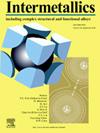Microstructure and mechanical properties of an aluminium composite with carbon-containing medium entropy alloy MoNbWTa0.5C0.5 reinforcement
IF 4.3
2区 材料科学
Q2 CHEMISTRY, PHYSICAL
引用次数: 0
Abstract
The work reports the synthesis and microstructural and mechanical characterization of an aluminium composite with carbon-containing medium entropy alloy (C-MEA), MoNbWTa0.5C0.5 as reinforcement. High energy ball milling of the C-MEA composition resulted in a pre-dominantly BCC phase. The Al-(C-MEA) composite was subsequently fabricated via a melting (at 800 °C) and solidification route and the FE-SEM and XRD characterization of the resultant composite revealed intermetallics of Al5(W, Mo), Al3(Ta, Nb) along with MoNbWTaC single-phase particles dispersed within the matrix of aluminium. The nano-hardness and elastic modulus of the C-MEA particles was observed to be 13 GPa and 190 GPa respectively. The microhardness of the bulk Al-(C-MEA) composite was found to be 686 MPa which is 89 % higher than aluminium at 353 MPa. Owing to the presence of hard and stiff C-MEAs and intermetallic particles, the yield strength of the composite was observed to be 102 % higher than aluminium. The Miedema's semi-empirical model was invoked to discuss the phase stability of the MEA particles and rationalize the formation of the Al5(W, Mo), Al3(Ta, Nb) intermetallics within the aluminium matrix.
求助全文
约1分钟内获得全文
求助全文
来源期刊

Intermetallics
工程技术-材料科学:综合
CiteScore
7.80
自引率
9.10%
发文量
291
审稿时长
37 days
期刊介绍:
This journal is a platform for publishing innovative research and overviews for advancing our understanding of the structure, property, and functionality of complex metallic alloys, including intermetallics, metallic glasses, and high entropy alloys.
The journal reports the science and engineering of metallic materials in the following aspects:
Theories and experiments which address the relationship between property and structure in all length scales.
Physical modeling and numerical simulations which provide a comprehensive understanding of experimental observations.
Stimulated methodologies to characterize the structure and chemistry of materials that correlate the properties.
Technological applications resulting from the understanding of property-structure relationship in materials.
Novel and cutting-edge results warranting rapid communication.
The journal also publishes special issues on selected topics and overviews by invitation only.
 求助内容:
求助内容: 应助结果提醒方式:
应助结果提醒方式:


